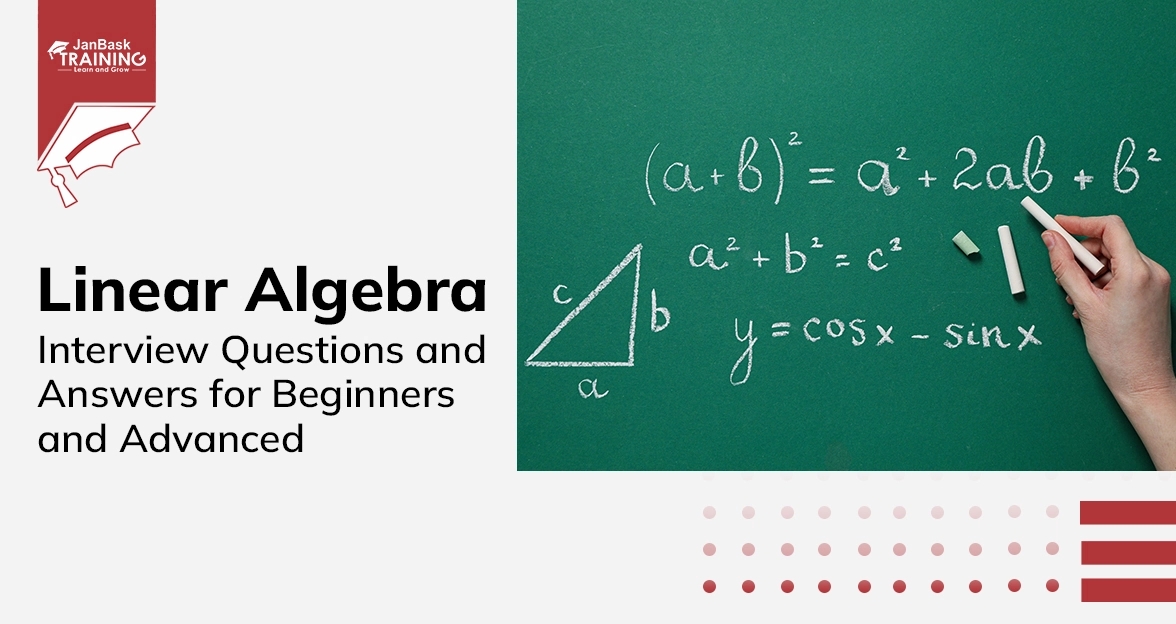 Grab Deal : Upto 30% off on live classes + 2 free self-paced courses - SCHEDULE CALL
Grab Deal : Upto 30% off on live classes + 2 free self-paced courses - SCHEDULE CALL

 Grab Deal : Upto 30% off on live classes + 2 free self-paced courses - SCHEDULE CALL
Grab Deal : Upto 30% off on live classes + 2 free self-paced courses - SCHEDULE CALL

Machine learning algorithms allow computers to recognize patterns and make decisions without being told precisely what to do, much like recipes for computers to learn from data. Today, we'll be talking about advanced machine learning algorithms with the help of these interview questions and answers. Advanced machine learning algorithms allow us to create complex models that can handle massive amounts of data and provide more accurate predictions.
These machine learning algorithms interview questions and answers for data science interviews will empower you to extract valuable knowledge and excel in this field!
A: A machine learning algorithm is a way for a computer system to do its job. It typically predicts outcomes based on given data. There are mainly two types: classification, which sorts data into categories, and regression, which predicts numerical values.
A: Deep learning is a fascinating recent development in machine learning. It is based on neural networks, a popular approach from the 1980s that then fell substantially out of style. But over the past five years, something happened, and suddenly, multi-layer (deep) networks began wildly outperforming, outperforming traditional approaches to classical problems in computer vision and natural language processing.
A: A decision tree is a binary branching structure used to classify an arbitrary input vector X. Each node in the tree contains a simple feature comparison against some field xi ∈ X, like "is xi ≥ 23.7?" The result of each such comparison is either true or false, determining whether we should proceed along the left or right child of the given node. These structures are sometimes called classification and regression trees (CART) because they can be applied to a broader class of problems.
A: Unsupervised methods try to find structure in the data by providing labels (clusters) or values (rankings) without any trusted standard. They are best used for exploration and for making sense of a data set otherwise untouched by human hands.
The mother of all unsupervised learning methods is clustering. Note that clustering can be used to provide training data for classification even in the absence of labels. If the clusters found represent genuine phenomena, we can then use the cluster ID as a label for all the elements in the given cluster.
These can now serve as training data to build a classifier to predict the cluster-ID. Predicting cluster IDs can be helpful even if these concepts do not have a name associated with them, providing a reasonable label for any input record q.
A: The gap between supervised and unsupervised learning is filled by semi-supervised learning methods, which amplify small amounts of labeled training data into more. Turning small numbers of examples into more significant numbers is often called bootstrapping, from the notion of "pulling yourself up from your bootstraps." Semi-supervised approaches personify the cunning that needs to be deployed to build substantive training sets.
Such approaches benefit enormously from having a reliable evaluation set. We need to establish that the model trained on the bootstrapped example performs better than the one trained on what we started with. Adding billions of training examples is only helpful if the labels are suitable.
A: Feature engineering is the fine art of applying domain knowledge to make it easier for machine learning algorithms to do their intended job. In the context of our taxonomy here, feature engineering can be considered an essential part of supervised learning, where the supervision applies to the feature vectors xi instead of the associated target annotations yi.
It is essential to ensure that features are presented to models in a way that the model can adequately use them. Incorporating application-specific knowledge into the data instead of learning it sounds like cheating to amateurs. However, the pros understand that there are things that cannot be learned quickly and, hence, are better explicitly put into the feature set.
A: Supervised Learning: It's like teaching a machine by giving it examples. You provide the algorithm with data that has both input and output known, and it figures out how to predict outputs based on inputs. It keeps learning and correcting its predictions until they are accurate.
Semi-supervised Learning: Similar to supervised learning, it uses both labeled (explained) and unlabeled (unexplained) data. This helps the algorithm learn to label data even when some of it isn't explained.
Unsupervised Learning: Here, the algorithm studies data to find patterns without any guide or answer key. It organizes data to describe its structure, like grouping similar data or organizing it in some logical way.
Reinforcement Learning: It's about learning from trial and error. The algorithm is given a set of actions, rules, and goals. It explores different options and learns from past experiences to make better decisions in the future.
A: Dimension reduction techniques, such as singular-value decomposition, play a crucial role in enhancing machine learning models by reducing large feature vectors to more robust and concise representations. By eliminating irrelevant features before model fitting, dimension reduction helps prevent overfitting and reduces training times while enhancing model performance.
Indicators that suggest a feature may be irrelevant include poor correlation with the target variable and the absence of any qualitative reasoning for how the feature might impact the target variable. By removing such features from the dataset, dimension reduction techniques enable models to focus on the most relevant information, leading to improved generalization and noise reduction from observations.
A: Here are some commonly used machine learning algorithms:
Naïve Bayes Classifier Algorithm (Supervised Learning - Classification):
This algorithm predicts categories (like spam or not spam) based on features (like words in an email) using probability.
It's simple but effective, often outperforming more complex methods.
K Means Clustering Algorithm (Unsupervised Learning - Clustering):
This algorithm groups data without predefined categories into clusters.
It finds groups based on similarities in the data.
Support Vector Machine Algorithm (Supervised Learning - Classification):
These algorithms classify data based on provided examples.
They build models to assign new data points to categories.
Linear Regression (Supervised Learning/Regression):
It helps understand relationships between two continuous variables.
For example, it can predict house prices based on square footage.
Logistic Regression (Supervised Learning – Classification):
It predicts the probability of an event happening based on past data.
It's used for binary outcomes, like whether a customer will buy a product or not.
Artificial Neural Networks (Reinforcement Learning):
These are computer systems inspired by the brain.
They're made of interconnected units that work together to solve problems.
They're used in various tasks, from recognizing images to playing games.
A: A few dimensions to understand the strengths and weaknesses of machine learning models include:
Power and expressibility: Machine learning methods differ in the richness and complexity of the models they support. Linear regression fits linear functions, while nearest-neighbor methods define piecewise-linear separation boundaries with enough pieces to approximate arbitrary curves. Greater expressive power provides the possibility of more accurate models, as well as the dangers of overfitting.
Interpretability: Powerful methods like deep learning often produce completely impenetrable models. They might provide very accurate classification in practice, but they need to provide a human-readable explanation of why they make the decisions they do. In contrast, the most significant coefficients in a linear regression model identify the most powerful features, and the identities of nearest neighbors enable us to determine our confidence in these analogies independently.
Training speed: Methods differ significantly in how fast they fit the necessary parameters of the model, which determines how much training data you can afford to use in practice. Traditional linear regression methods can be expensive to fit for large models. In contrast, nearest neighbor Search requires almost no training time at all outside that of building the appropriate search data structure.
Prediction speed: Methods differ in how fast they make classification decisions on a new query q. Linear/logistic regression is fast; it just computes a weighted sum of the fields in the input records. In contrast, nearest neighbor search requires explicitly testing q against a substantial amount of the training test. In general, there is a trade-off with training speed: You can pay me now or pay me later.
A: Discounting is a statistical technique to adjust counts for yet-unseen events by explicitly leaving probability mass available for them. The most straightforward and most popular technique is add-one discounting, where we add one to the frequency of all outcomes, including unseen.
For example, suppose we were drawing balls from an urn. After seeing five reds and three greens, what is the probability we will see a new color on the next draw? If we employ add-one discounting,
P(red) = (5 + 1)/((5 + 1) + (3 + 1) + (0 + 1)) = 6/11, and
P(green) = (3 + 1)/((5 + 1) + (3 + 1) + (0 + 1)) = 4/11,
leaving the new color a probability mass of
P(new-color) = 1/((5 + 1) + (3 + 1) + (0 + 1)) = 1/11.
For small numbers of samples or large numbers of known classes, the discounting causes a non-trivial damping of the probabilities. Our estimate for the probability of seeing a red ball changes from 5/8 = 0.625 to 6/11 = 0.545 when we employ add-one discounting. But this is a safer and more honest estimate, and the differences will disappear into nothingness after we have seen enough samples.
A: Some advantages of decision trees include:
Non-linearity: Each leaf represents a chunk of the decision space but is reached through a potentially complicated path. This chain of logic permits decision trees to represent highly complicated decision boundaries.
Support for categorical variables: Decision trees make natural use of categorical variables, like "if hair color = red," in addition to numerical data. Categorical variables fit less comfortably into most other machine learning methods.
Support for categorical variables: Decision trees make natural use of categorical variables, like "if hair color = red," in addition to numerical data. Categorical variables fit less comfortably into most other machine learning methods.
Robustness: The number of possible decision trees grows exponentially in the number of features and possible tests, which means that we can build as many as we wish. Constructing many random decision trees (CART) and taking the result of each as a vote for the given label increases robustness and permits us to assess the confidence of our classification.
A: The magic of SVMs is that this distance-feature matrix need not be computed explicitly. The optimization inherent in finding the maximum margin separator only performs the dot products of points with other points and vectors. Thus, we could imagine performing the distance expansion on the fly when the associated point is being used in a comparison. Hence, there would be no need to precompute the distance matrix: we can expand the points from d to n dimensions as needed, do the distance computation, and then throw the expansions away.
This would work to eliminate the space bottleneck, but we would still pay a heavy price in computation time. The fantastic thing is that there are functions called kernels, which return what is essentially the distance computation on the more significant vector without ever constructing the larger vector. Doing SVMs with kernels gives us the power to find the best separator over a variety of non-linear functions without much additional cost.
A: Topic modeling is a class of unsupervised methods typically associated with documents drawn over a given vocabulary. Documents are written about topics, usually a mix of topics. This book is partitioned into chapters, each about a different topic, but it also touches on subjects ranging from baseball to weddings. But what is a topic? Typically, each topic is associated with a particular set of vocabulary words.
Topic modeling is an unsupervised approach that infers the topics and the word lists from scratch, just given unlabeled documents. We can represent these texts by a w × d frequency matrix F, where w is the vocabulary size, d is the number of documents, and F[i, j] reflects how many times work i appears in document j.
Suppose we factor F into F ≈ W × D, where W is a w × t word–topic matrix and D is a t × d topic document matrix. The most significant entries in the ith row of W reflect the topics word wi is most strongly linked to, while the most significant entries in the jth column of D reflect the topics best represented in document dj.
A: Supervised learning is the bread-and-butter paradigm for classification and regression problems. We are given vectors of features xi, each with an associated class label or target value yi. The annotations yi represent the supervision, typically derived from some manual process that limits the potential amount of training data.
In specific problems, the annotations of the training data come from observations in interacting with the world or at least a simulation of it. Google's AlphaGo program was the first computer program to beat the world champion at Go. A position evaluation function is a scoring function that takes a board position and computes a number, estimating how strong it is.
AlphaGo's position evaluation function was trained on all published games by human masters, but much more data was needed. The solution was to build a position evaluator by training against itself. Position evaluation is substantially enhanced by search – looking several moves ahead before calling the evaluation function on each leaf.
Trying to predict the post-search score without the search produces a more robust evaluation function. Generating this training data is just a result of computation: the program playing against itself.
This idea of learning from the environment is called reinforcement learning. It cannot be applied everywhere, but it is always worth looking for clever approaches to generate mechanically annotated training data.
JanBask Training's data science courses are designed to equip professionals with the skills and knowledge needed to excel in this field. Our comprehensive training programs cover a wide range of topics, including machine learning algorithms, data analysis techniques, and advanced modeling methods. By completing these courses, professionals can enhance their expertise and stay competitive in today's rapidly evolving job market.

Statistics Interview Question and Answers


Data Warehouse Interview Question And Answers in 2024

Cyber Security

QA

Salesforce

Business Analyst

MS SQL Server

Data Science

DevOps

Hadoop

Python

Artificial Intelligence

Machine Learning

Tableau
Download Syllabus
Get Complete Course Syllabus
Enroll For Demo Class
It will take less than a minute
Tutorials
Interviews
You must be logged in to post a comment